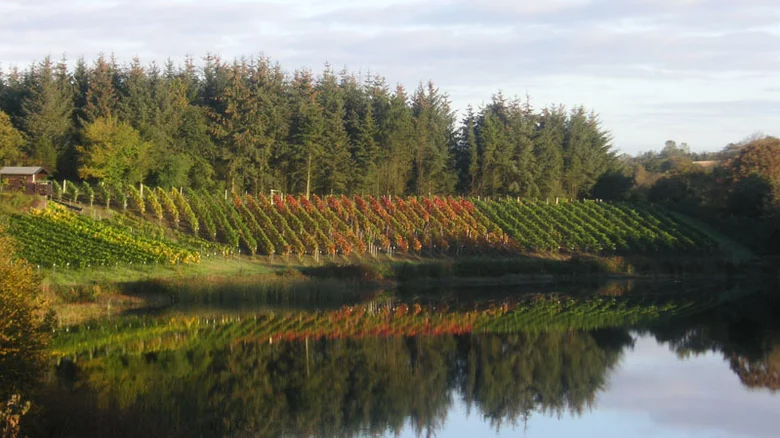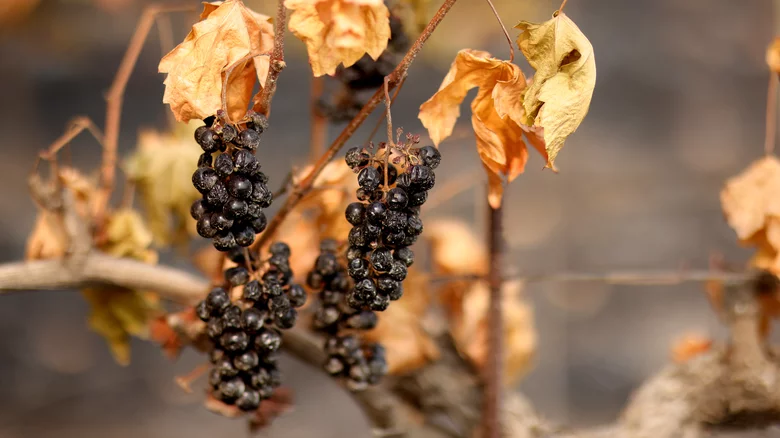By Chloé Astor St. Clair (originally published on Tasting Table on Sept. 13, 2022)

Climate change is impacting our food and wine. According to the World Economic Forum, climate change and extreme weather events are creating inhospitable environments for many foods, including wine grapes, indicating that they may become extinct in a few decades. Favorite foods like chocolate, coffee beans, avocados, berries, stone fruit like plums, cherries, peaches, and apricots, along with bananas, corn, chickpeas, peanuts, and grains, may all disappear in the next few decades due to climate change.
Grapes are particularly susceptible to changes in temperature, water supply, and sun exposure. Because grapes respond to even the subtlest changes in climate, they are considered an indicator crop: reporting on eventual threats to other food crops, per the book “Wine and Climate Change.” The book continues; that in traditional wine regions across much of Europe, spring is plagued with unpredictable frosts that harm and kill delicate young flowers on grapevines impacting the quantity and quality of the fruit. Frost can damage or kill young vines and new growth. Summers are hotter and drier, making thirsty vines and grapes shrivel. The grapes may reach maturity, but often they don’t attain phenolic ripeness giving them the flavors, acidity, and tannins desirable for the signature wines they produce. Autumn is delayed, pushing harvest dates and impacting the dormancy grapevines need to survive, and winters deliver more volatile storms that hurt or kill perennial plants like grapevines. New vines take years to establish before they begin producing fruit.
Wine geography is changing
Dr. Lee Hannah, the senior researcher of climate change at Conservation International in California, predicted vast changes to the global wine industry with the release of his 2013 paper, “Climate change, wine, and conservation,” which included a series of predictive maps (pictured) expressing how, when, and where climate change will impact wine regions in Europe, North and South America, South Africa, and Australia.
At the time, wine insiders disputed his timeline of just 30 years, but a decade later, nobody refutes his claims. The paper reports that due to climate change, by 2050, many traditional wine regions across Europe, from the Mediterranean to the northern seas, will become less suitable for growing wine grapes, including the Champagne region, and prosperous Spanish, Portuguese, French, Italian, and German wine regions. The map (pictured) indicates red zones, including most classic wine regions, which will become uninhabitable for grapes. The green zones will remain viable, and the blue zones will open up new possibilities and emerging regions. Emerging regions across Canada, England, Scandinavia, and China are growing wine grapes.
Hannah continues that even amidst massive and destructive droughts and fires across California, its famous wine regions, including Napa and Sonoma, will benefit from climate change for now. It won’t last long. Wine grapes only thrive under specific climate circumstances and require warm, sunny days and cool nights to produce the best fruit, Climate Central. Grapes dislike even the slightest fluctuations in temperature norms, water availability, and humidity.
High heat destroys wine grapes
Heat continues to be one of the biggest threats to wine grapes, which prefer cooler temperatures than table grapes. According to Climate Central, the average growing season temperature has increased an average of 2 degrees Fahrenheit since 1970 in the USA, and similar increases are occurring in most European wine regions. Wine and climate expert Dr. Greg Jones states that some grape varietals like pinot noir, and its siblings, pinot gris and pinot blanc, cannot withstand more than a 3.6-degree Fahrenheit change. If 2 degrees is the average, some regions have exceeded the heat requirements for pinot noir. Jones continues that these temperature changes affect the quality of wine, improving some and destroying others, per Climate Central.
Wine producers are adopting regenerative and sustainable agriculture and vinification practices hoping to mitigate the effects of climate change. Most wine regions are controlled by strict regulations governing irrigation policies, crop yield, and what types of grapes can be grown. Mitigating the effects of climate change requires rewriting and amending these laws. Bureaucracy moves slowly in vulnerable countries like France, which in 2019, finally approved changes in Bordeaux, arguably one of the greatest wine regions. French lawmakers now allow six heat-resistant Portuguese grape varietals to be grown in the esteemed Bordelaise vineyards as a means to adapt to rising temperatures, per Decanter. Planting different grape varietals, using hybrids and indigenous grapes, is an increasingly important tactic of mitigation.
Why Most Wine Production Could Be Lost In The Next 50 Years
Justin Sullivan/Getty Images
BY CHLOÉ ASTOR ST. CLAIR/SEPT. 13, 2022 9:47 AM EDT
Climate change is impacting our food and wine. According to the World Economic Forum, climate change and extreme weather events are creating inhospitable environments for many foods, including wine grapes, indicating that they may become extinct in a few decades. Favorite foods like chocolate, coffee beans, avocados, berries, stone fruit like plums, cherries, peaches, and apricots, along with bananas, corn, chickpeas, peanuts, and grains, may all disappear in the next few decades due to climate change.
Grapes are particularly susceptible to changes in temperature, water supply, and sun exposure. Because grapes respond to even the subtlest changes in climate, they are considered an indicator crop: reporting on eventual threats to other food crops, per the book “Wine and Climate Change.” The book continues; that in traditional wine regions across much of Europe, spring is plagued with unpredictable frosts that harm and kill delicate young flowers on grapevines impacting the quantity and quality of the fruit. Frost can damage or kill young vines and new growth. Summers are hotter and drier, making thirsty vines and grapes shrivel. The grapes may reach maturity, but often they don’t attain phenolic ripeness giving them the flavors, acidity, and tannins desirable for the signature wines they produce. Autumn is delayed, pushing harvest dates and impacting the dormancy grapevines need to survive, and winters deliver more volatile storms that hurt or kill perennial plants like grapevines. New vines take years to establish before they begin producing fruit.
Wine geography is changing

Dr. Lee Hannah, the senior researcher of climate change at Conservation International in California, predicted vast changes to the global wine industry with the release of his 2013 paper, “Climate change, wine, and conservation,” which included a series of predictive maps (pictured) expressing how, when, and where climate change will impact wine regions in Europe, North and South America, South Africa, and Australia.
At the time, wine insiders disputed his timeline of just 30 years, but a decade later, nobody refutes his claims. The paper reports that due to climate change, by 2050, many traditional wine regions across Europe, from the Mediterranean to the northern seas, will become less suitable for growing wine grapes, including the Champagne region, and prosperous Spanish, Portuguese, French, Italian, and German wine regions. The map (pictured) indicates red zones, including most classic wine regions, which will become uninhabitable for grapes. The green zones will remain viable, and the blue zones will open up new possibilities and emerging regions. Emerging regions across Canada, England, Scandinavia, and China are growing wine grapes.
Hannah continues that even amidst massive and destructive droughts and fires across California, its famous wine regions, including Napa and Sonoma, will benefit from climate change for now. It won’t last long. Wine grapes only thrive under specific climate circumstances and require warm, sunny days and cool nights to produce the best fruit, Climate Central. Grapes dislike even the slightest fluctuations in temperature norms, water availability, and humidity.
High heat destroys wine grapes

Heat continues to be one of the biggest threats to wine grapes, which prefer cooler temperatures than table grapes. According to Climate Central, the average growing season temperature has increased an average of 2 degrees Fahrenheit since 1970 in the USA, and similar increases are occurring in most European wine regions. Wine and climate expert Dr. Greg Jones states that some grape varietals like pinot noir, and its siblings, pinot gris and pinot blanc, cannot withstand more than a 3.6-degree Fahrenheit change. If 2 degrees is the average, some regions have exceeded the heat requirements for pinot noir. Jones continues that these temperature changes affect the quality of wine, improving some and destroying others, per Climate Central.
Wine producers are adopting regenerative and sustainable agriculture and vinification practices hoping to mitigate the effects of climate change. Most wine regions are controlled by strict regulations governing irrigation policies, crop yield, and what types of grapes can be grown. Mitigating the effects of climate change requires rewriting and amending these laws. Bureaucracy moves slowly in vulnerable countries like France, which in 2019, finally approved changes in Bordeaux, arguably one of the greatest wine regions. French lawmakers now allow six heat-resistant Portuguese grape varietals to be grown in the esteemed Bordelaise vineyards as a means to adapt to rising temperatures, per Decanter. Planting different grape varietals, using hybrids and indigenous grapes, is an increasingly important tactic of mitigation.
Higher elevation and latitudes may preserve the wine industry

Mitigation will only go so far in staving off the inevitable. Migration is becoming an obvious answer for many European brands. French champagne producers are making their signature fizzy wine styles in England, a slightly cooler region a few latitude degrees north of Champagne.
When it comes to the geography of wine, elevation and latitude are key components for optimal wine-producing capabilities. Climate change is forcing changes to traditional wine geography. Vineyards are moving to higher elevations and latitudes, offering a respite from the heat.
There is hope for the wine industry in emerging regions like Dons in Denmark, Sussex and Kent in England, British Columbia, Nova Scotia, and many Scandinavian countries. These regions rely heavily on cold-hardy grape varietals and hybrid crosses. Often, these grapes produce flavors consumers deem strange. The wine industry must retrain the wine drinker’s palate to accept the new styles of wines that will be produced in places unimaginable 20 years ago, like England, Norway, Denmark, Sweden, Siberia, and Nova Scotia. Already, these countries have dozens of new vineyards and wineries producing wine, per “Wine and Climate Change.”
British, Scandinavian, and Canadian wine regions emerge

TheNewGastronome indicates that new wineries are opening across Scandinavia including Ørnberg Vin, Njord Vingaard, and Skærsøgaard Vin, in Denmark; Vingården i Klagshamn, Fredholms vin, and Köpingsbergs vingård, in Sweden; Lerkekåsa, Kvelland vingård, and Egge gård in Norway.
Skærsøgaard Vin, in the Dons wine region, which received Denmark’s first PDO (Protected Designation of Origin) for wine in 2018, focuses on sparkling wine. Not yet rivaling champagne just yet, like England fizz, but Scandinavian wines are improving in quality.
The tiny island of Nova Scotia, just off Canada’s eastern coast, began producing wines in the 1970s and now boasts more than 20 wineries, per Visit Nova Scotia Wineries. British Columbia, Canada’s furthest west province, has a thriving wine industry, with nine wine regions that produce award-winning wines, reveals BC Wine.
Even the harshest critic of the climate change rhetoric only needs to look around at the world and the evidence: science is proving that the planet is warming, storms are increasing in number and volatility, fires are burning more frequently and hotter, and plants and animals — humans included — are suffering. The cause of climate change continues to be debated, but the real issue is that the damage is done, and the ramifications are getting worse each year. If the prediction models are correct, we have 28 years left to enjoy the popular wines we drink today.










